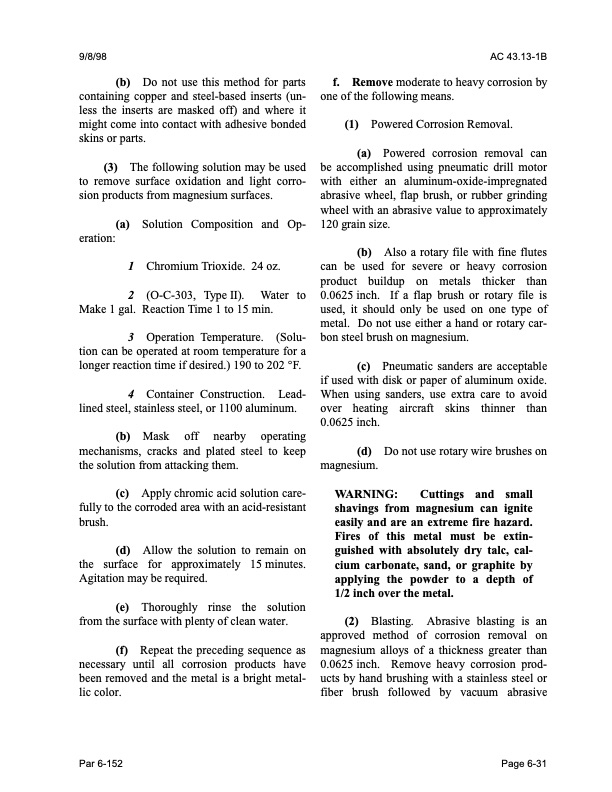
PDF Publication Title:
Text from PDF Page: 301
9/8/98 AC 43.13-1B (b) Do not use this method for parts containing copper and steel-based inserts (un less the inserts are masked off) and where it might come into contact with adhesive bonded skins or parts. (3) The following solution may be used to remove surface oxidation and light corro sion products from magnesium surfaces. f. Remove moderate to heavy corrosion by one of the following means. (1) Powered Corrosion Removal. (a) Powered corrosion removal can be accomplished using pneumatic drill motor with either an aluminum-oxide-impregnated abrasive wheel, flap brush, or rubber grinding wheel with an abrasive value to approximately 120 grain size. (b) Also a rotary file with fine flutes can be used for severe or heavy corrosion product buildup on metals thicker than 0.0625 inch. If a flap brush or rotary file is used, it should only be used on one type of metal. Do not use either a hand or rotary car bon steel brush on magnesium. (c) Pneumatic sanders are acceptable if used with disk or paper of aluminum oxide. When using sanders, use extra care to avoid over heating aircraft skins thinner than 0.0625 inch. (d) Do not use rotary wire brushes on magnesium. WARNING: Cuttings and small shavings from magnesium can ignite easily and are an extreme fire hazard. Fires of this metal must be extin- guished with absolutely dry talc, cal- cium carbonate, sand, or graphite by applying the powder to a depth of 1/2 inch over the metal. (2) Blasting. Abrasive blasting is an approved method of corrosion removal on magnesium alloys of a thickness greater than 0.0625 inch. Remove heavy corrosion prod ucts by hand brushing with a stainless steel or fiber brush followed by vacuum abrasive eration: (a) Solution Composition and Op 1 Chromium Trioxide. 24 oz. 2 (O-C-303, Type II). Water to Make 1 gal. Reaction Time 1 to 15 min. 3 Operation Temperature. (Solu tion can be operated at room temperature for a longer reaction time if desired.) 190 to 202 °F. 4 Container Construction. Lead- lined steel, stainless steel, or 1100 aluminum. (b) Mask off nearby operating mechanisms, cracks and plated steel to keep the solution from attacking them. (c) Apply chromic acid solution care fully to the corroded area with an acid-resistant brush. (d) Allow the solution to remain on for approximately 15 minutes. the surface Agitation may be required. (e) Thoroughly rinse the solution from the surface with plenty of clean water. (f) Repeat the preceding sequence as necessary until all corrosion products have been removed and the metal is a bright metal lic color. Par 6-152 Page 6-31PDF Image | AFS-640

PDF Search Title:
AFS-640Original File Name Searched:
ac_43.13-1b_w-chg1.pdfDIY PDF Search: Google It | Yahoo | Bing
5,000 BF Shipping Container Lumber Dry Kiln For Quality Lumber The 5,000 BF container kiln consists of one 40 foot high-cube aluminum shipping container... More Info
Shipping Container Lumber Dry Kilns by Global Energy Global Energy designed and developed the container kiln back in 1991. The purpose is to give access to portable sawmill owners, furniture makers, and small business the value added profit of dry kiln lumber and quality hardwoods... More Info
Vacuum Kiln Conversion Kit for Lumber and Wood Dry Kilns Convert your existing conventional dry kiln into a fast drying vacuum kiln. Similar to vacuum bagging in the boat building and aircraft industry, we have come up with a proprietary process which allows you to build a very simple vacuum kiln at a fraction of the price, and without the intensive conventional metal chamber structure... More Info
Vacuum Pump Cart System for Bagging Clamping Wood Drying and more Vacuum Cart with 2HP Pump and Dual Pistons with multiple multiplex vacuum ports and liquid reservoir... More Info
Vacuum Bagging Basics Vacuum bagging is a method of clamping, which has traditionally been used in the composites industry, but can also be used for vacuum drying materials, including wood products... More Info
| CONTACT TEL: 608-238-6001 Email: greg@globalmicroturbine.com | RSS | AMP |